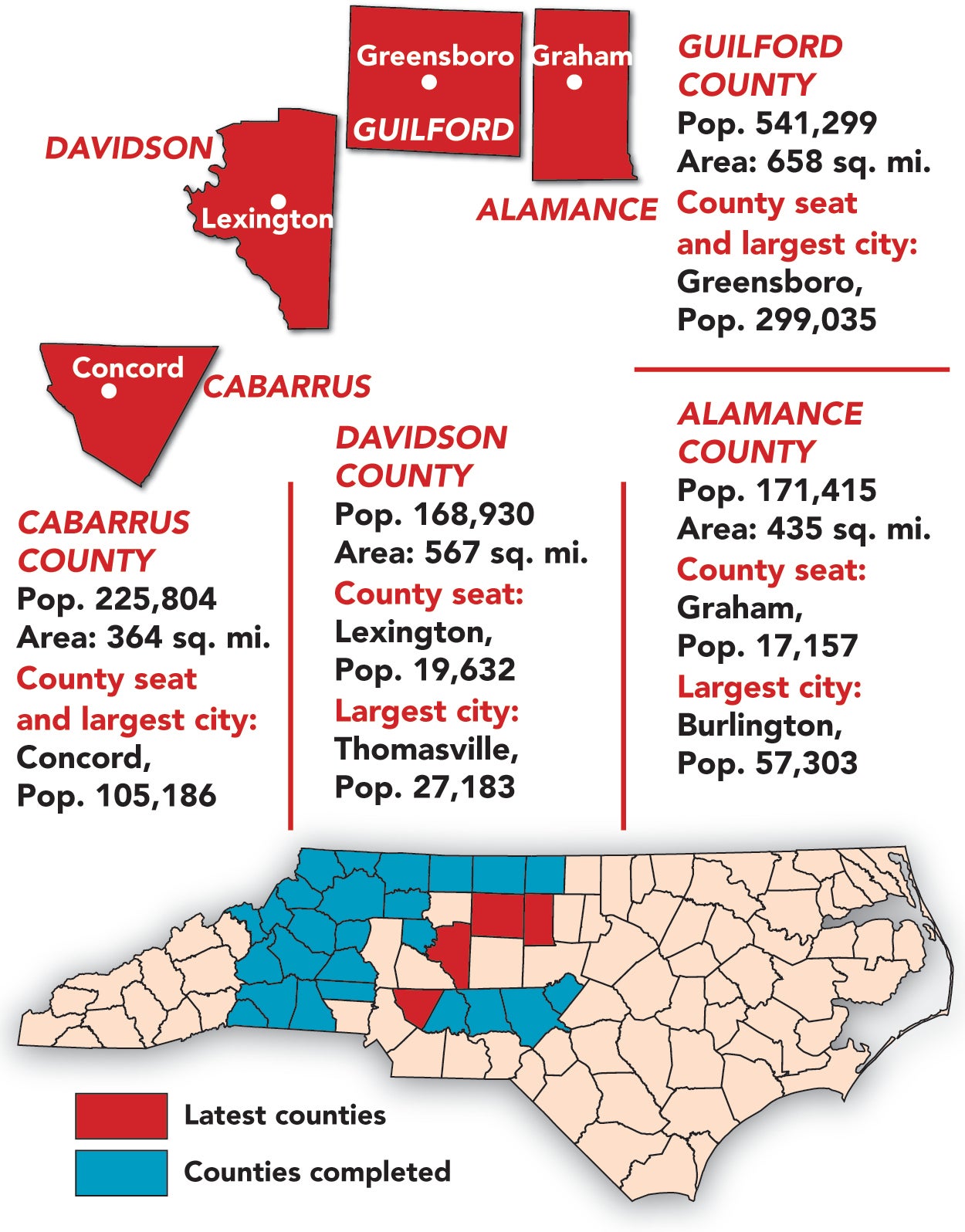DAVID FREEZE COLUMN: More county seats along the interstate, but all with interesting downtowns
Editor’s Note: David Freeze is a runner, running coach and long-distance cyclist from China Grove in Rowan County. He is completing a challenge to run in a few miles in every county seat in all 100 N.C. counties. Contact him at david.freeze@ctc.net.

I’m so much enjoying these visits to the county seats in North Carolina and used April 23, to add to my list.

David Freeze
First I wanted to visit Greensboro, county seat of Guilford, with less traffic. The old part of town was called Greensborough, formed in 1808, and is centered on Washington and Elm streets.
The name changed to Greensboro in 1895. I ran several races in that area years ago, but this was my first time exploring the same streets.
Right away, I found the modern courthouse just by being lucky to park near it. Just ahead. I found the old Carolina Theatre which opened on Halloween 1927, and the site where Jefferson Davis held two of his last cabinet meetings after the Confederate President had fled Richmond in 1865.
Next was the Cigar District, a big thing from 1903-55, employing mostly young women in 14 manufacturing shops on Elm Street.
In this area, Blue Duck electric scooters and bikes were parked everywhere for rent, a couple on a corner, another here or there.
North Carolina’s first and only women’s Holocaust monument was unveiled at LeBauer Park on April 18. The statue, “She Wouldn’t Take Off Her Boots,” was designed in a shop on Elm Street.
I visited the sprawling depot that serves Amtrak, Greyhound, city transportation and probably more.
The F.W. Woolworth store where four Black college freshmen sat down for lunch in the “whites only” section is now a Civil Rights Museum. Vicks VapoRub was created in a drug store nearby.
The most impressive buildings in this area are the Lincoln Financial Tower at 20 stories next to the 18-story Jefferson Standard Building.
The old town is full of interesting stores, most of them in historic buildings.
Modern Greensboro has lots of bagel stores and I had to visit one on the way out of town. I ate more bagels today than I have in total the last two months.
My next county seat was Graham, of Alamance. Graham became a town in 1851. It’s another town that surrounds the county courthouse built in 1923 and is loaded with interesting historic buildings.
Parking was at a premium, with several large churches, shopping and one particular restaurant busy late on a Sunday morning.
The Montwhite Building from 1907 was the Opera House first and one of the 70 downtown historic structures. There are several large historic mill buildings, too, one with a separate bathroom building added in 1940.
The 1902 Wrike Drugs is still in the original building with only the store front altered. The movie “Jesus Resolution” was showing all afternoon in the cinema building.
Most surprising to me was that the Press Restaurant offering coffee, crepes and cocktails had a 90-minute wait for a table.
Graham is one of the few flat downtowns so far and has plenty to visit.
Then I drove on to Lexington, another historic downtown that I haven’t spent enough time in over the years. Lexington was incorporated in 1828 and named after Lexington, Massachusetts.
I found a fantastic Old Davidson County Courthouse, now a museum, first built in 1858. The interior was burned in 1865 and repaired in 1867. I remain amazed at the quality, style and beauty of these old courthouses and this one is one of the best yet.
Two Lexington fixtures began with the Conrad Hinkle grocery store, built in 1919. Famous for old-time homemade things like pimento cheese and chicken salad plus hand-cut meats, the store remains very popular.
Just down the street is Lanier Hardware. Opened in 1940 and still operated by the Lanier family, locals say that if Lanier’s doesn’t have it in its 32,000 square feet of space, you don’t need it.
The old post office became a library building but appears unused now. Decorative pigs are scattered along the sidewalks and each one advertises something different. Lexington calls itself the Barbecue Capital of the World.
Especially good was a statue near the police department of a uniformed officer holding the hand of a little girl while he talked with her. Bike racks along the sidewalk were placed in honor of local citizens.
And the Sinfully Delicious custom bakery was taking orders for Elvis cakes. I hoped to visit again April 30 as the three-day 2nd Annual Elvis Festival targeted a gospel competition.
The last city for this week is Concord, Cabarrus County’s seat. Concord means “to bring into harmony” and was first settled about 1750 and incorporated in 1806. It is the 10th largest city in North Carolina.
Cotton and textile mills were stalwart industries as the city prospered. The 1839 Odell-Locke-Randolph Mill is now a popular retail space. Union Street is the one of the most beautiful streets I have ever seen with more than 200 historic structures.
Often I have gone to Concord just to run out and back on Union, ending in the downtown area.
The historic and stately Cabarrus County Courthouse was built in 1876, one of four courthouses used since the town’s inception. Government buildings dominate the downtown area, with current courthouse expansion still underway and various city and county buildings. The City Hall and Cabarrus County Sheriff’s Office and Detention Center, in particular, were especially interesting.
Several large murals, one honoring the hometown Avett Brothers, can be seen, along with one of the original What-a-Burgers, labeled as location No. 2 on it’s sign.
A giant step forward is the streetscape construction now underway on downtown Union Street. When complete, bike lanes, significant landscape plantings and widened walking areas will highlight the area. Concord looks successful and growing, and I’m betting that continues.
Now with 30 county seats complete, 70 remain. I had 6.27 miles on foot in these four towns, all very enjoyable. We’ll continue soon.

